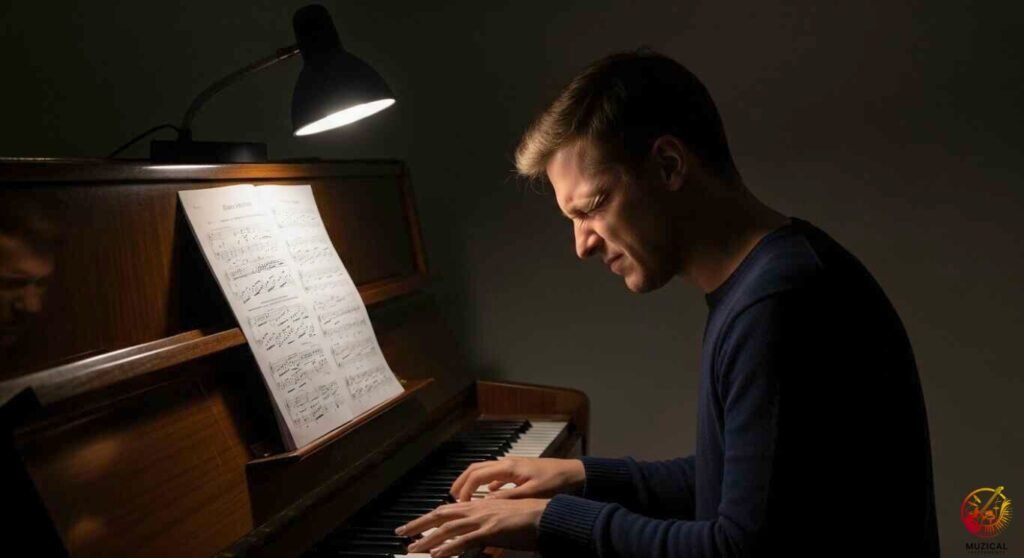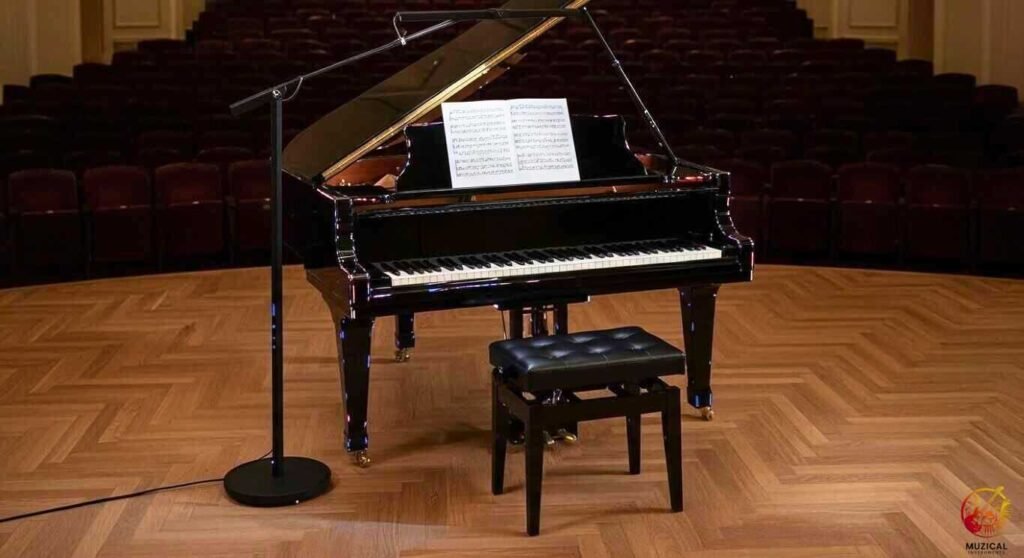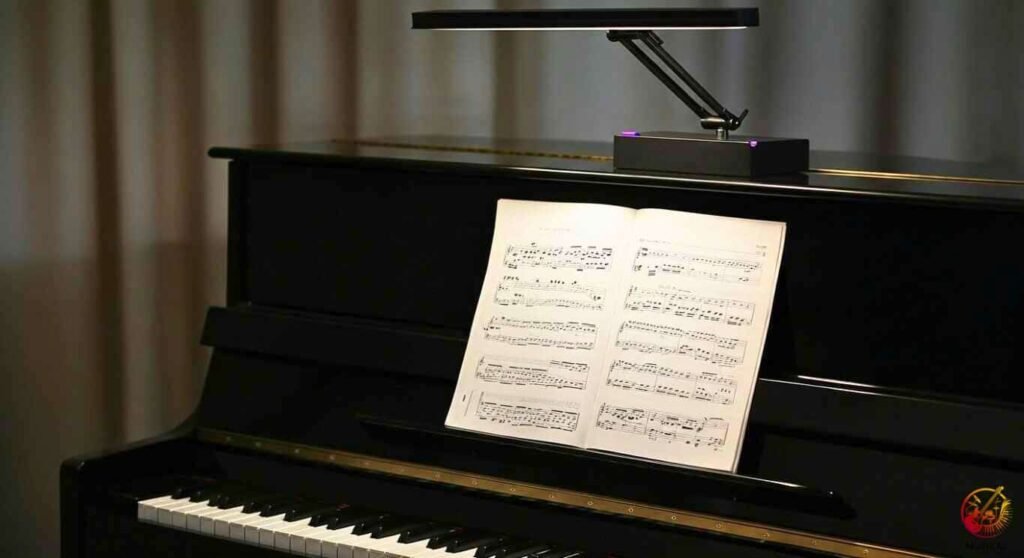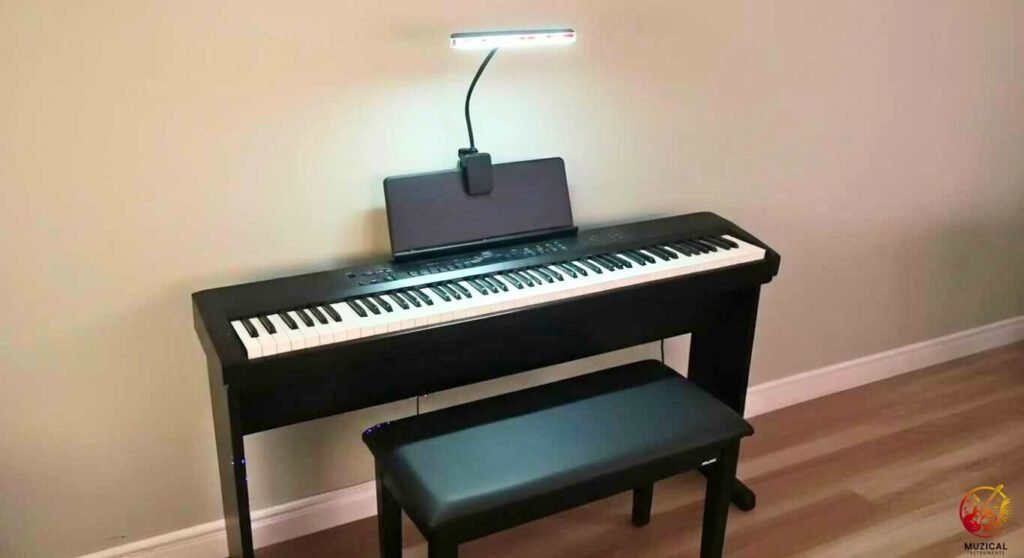How to Choose the Right LED Piano Lamp for Your Instrument
Most pianists struggle to read sheet music under regular room light. The overhead lights often cast shadows across the pages, making it hard to see clearly. Your eyes start to strain during evening practice sessions.
An LED piano lamp solves this problem, but picking the wrong one means wasted money and continued frustration.
This guide will show you exactly how to choose a LED piano lamp that works for your instrument and lets you play for hours, comfortably.
Why Can’t I Just Use a Regular Desk Lamp?

This is the biggest mistake I see. A standard desk lamp is not a piano desk lamp. They just aren’t built for the job.
Why?
- Problem 1: Uneven Light. A normal lamp has a “hotspot.” It lights up the middle of your page, but the top corners and bottom lines are left in the shadows.
- Problem 2: Glare. Desk lamps shine light straight down. This light bounces off your glossy music paper and shiny piano keys, creating a mirror-like glare that makes it harder to see.
- Problem 3: Wrong Height. Most desk lamps are too short. They sit below the top of your music, which casts annoying shadows from the page or your hands.
A dedicated LED piano lamp is designed to solve these three specific problems. It spreads a wide, even band of light across the entire music stand and keys, all while staying out of your eyes.
What’s the Best LED Piano Lamp for My Specific Piano?
This is the most common question I get. The “best” lamp for a grand piano is the “wrong” lamp for a digital keyboard.
Here’s a quick piano lamp buying guide for your specific instrument.
Best Lamp for a Grand Piano (or Baby Grand)

- The Challenge: A grand piano’s music desk is large and sits far back from the piano’s edge.
- The Solution: You need a lamp with height and reach.
- Best Options:
- Floor Lamp: This is the classic solution. A tall grand piano LED lamp (like those from brands Cocoweb or House of Troy) has a heavy base and a long arm that arches up and over the music.
- Weighted Desk Lamp: This can work if it’s tall enough (at least 15-20 inches) and has a long arm. You’ll place it on the side of the piano.
Best Lamp for an Upright Piano

- The Challenge: The music desk is vertical, and the top of the piano is flat.
- The Solution: You can place the lamp right on the piano or on the music desk itself.
- Best Options:
- Top of Piano Lamp: This is the traditional piano lamp for an upright piano. It has a heavy, wide base that sits securely on the piano’s flat top. The long, horizontal shade shines down perfectly on the music.
- Clip on Lamp: This is my favorite modern option. A wide, bar style LED lamp clips right to the top of the music desk. It’s secure, perfectly positioned, and takes up zero space.
Best Lamp for a Digital Piano or Keyboard

- The Challenge: Digital pianos come in all shapes. Some have wide music stands; some are just a slim keyboard.
- The Solution: You need flexibility.
- Best Options:
- Clip on Lamp: This is almost always the best choice. It clips to the built-in music stand, giving you perfect light right where you need it.
- Weighted Desk Lamp: A piano desk lamp with a flexible gooseneck is a great runner up. You can place it on a small table beside your keyboard.
| Piano Type | Best Lamp Style(s) | Why It Works |
|---|---|---|
| Grand / Baby Grand | 1. Floor Lamp 2. Tall Desk Lamp | Needs a long reach and height to get the light over the large music desk. |
| Upright Piano | 1. Top-of-Piano Desk Lamp 2. Clip-on Lamp | Sits securely on the piano’s flat top or clips directly to the music desk. |
| Digital / Keyboard | 1. Clip-on Lamp 2. Gooseneck Desk Lamp | Offers the most flexibility for different-sized music stands and setups. |
The 5 Key Features to Look For in an LED Piano Lamp
I’ve helped musicians shop for lamps, and I’ve tested all kinds. It all comes down to these five things. Get these right, and you’ll love your lamp.
1. Light Coverage (Width is Everything)
This is the most important feature. Your lamp must be wide enough to light up both pages of an open music book.
If the lamp head is too narrow, you’ll be shuffling it back and forth.
- Look for: A wide lamp head or a long light bar.
- The magic number: Aim for a lamp head that is at least 19 inches wide, or even wider for large scores.
This wide coverage is what gives you that perfectly even illumination from the first note on the left page to the last note on the right.
2. Light Quality (Lumens, CRI, and Color)
This sounds technical, but it’s super simple. These three terms are your secret weapon for finding the best LED piano lamp.
Lumens (Brightness):
This is just a measure of how bright the light is. You don’t want a stadium light, but you also don’t want a dim candle.
- Aim for: 300 to 500 lumens. This is the sweet spot for reading music without creating new glare.
- Bonus feature: Get a lamp with a dimmer. This lets you adjust the brightness for a sunny afternoon or a dark evening.
CRI (Color Rendering Index):
This is a huge deal, and most people ignore it. CRI measures how “true” colors look under the light. A low CRI makes everything look washed out and gray.
- Why it matters: You want your black notes to look sharp and black, not faded. If you use a red pen for notes, you want it to look red.
- Aim for: A CRI of 90 or higher. This gives you crisp, clear, high contrast light that makes music much easier to read.
CCT (Correlated Color Temperature):
This is the “color” of the light itself. Is it a warm, cozy yellow, or a cool, sterile blue? It’s measured in Kelvins (K).
- Warm White (2700K–3000K): This is the color of a classic lightbulb. It’s cozy and good for a living room, but it can make you feel sleepy and can make reading music harder.
- Cool White (5000K+): This is a harsh, blue-ish light, like in a hospital or office. It can feel sterile and cause eye fatigue during long practice sessions.
- The Winner: Natural/Neutral White (4000K–4500K): This is the sweet spot. It’s like clear daylight, bright and focused, but not harsh. It’s the best for focus and color accuracy.
Here’s a simple breakdown.
| Feature | What It Is | What to Look For (The Sweet Spot) |
|---|---|---|
| Lumens (Brightness) | How much light it puts out. | 300-500 lumens. A dimmer is a huge plus. |
| CRI (Color Accuracy) | How “true” colors look. (Scale of 0-100) | 90+ CRI. This is non-negotiable for serious playing. |
| CCT (Light Color) | The warmth or coolness of the light. | 4000K (Natural White). Best for focus and reading. |
3. Adjustability and Reach
An adjustable LED piano lamp is a must have. You need to be able to control exactly where the light goes.
The goal is simple: Aim the light at the music, not at your eyes.
- Gooseneck: A flexible gooseneck is the easiest way to get the perfect angle. You can bend it to the exact spot you need.
- Pivot Points: Other lamps have arms with multiple pivot points (at the base, in the middle) to raise, lower, and tilt the lamp head.
You must be able to position the light above your line of sight and angle it down at the page. This is key to killing glare.
4. Glare Control (The Secret Sauce)
Glare is the #1 enemy of a piano player. It bounces off white keys and glossy pages, causing you to squint.
The best LED piano lamps have built-in glare control.
- Asymmetrical Lighting: This is a fancy term for a smart design. The shade is built to throw light forward (onto the music) instead of just down (onto the keys). This is a game changer.
- Diffuser: Look for a lamp that has a frosted or “diffused” cover over the LED bulbs. This softens the light, spreading it out and preventing the harsh, sharp reflections you get from bare bulbs.
5. Base Style and Stability
Where will the lamp sit? The base is just as important as the light itself.
- Weighted Base: This is the most common style. It’s a heavy, solid base that sits on top of your upright piano or on a table next to your digital keyboard. It needs to be heavy so it doesn’t tip over when you extend the arm.
- Clip-on Base: A clip-on lamp is a fantastic, space-saving option. It clamps directly onto the music desk of your upright or digital piano. Just make sure the clamp is padded with foam or rubber so it doesn’t scratch your instrument.
- Floor Lamp: This is the most flexible option and is often the best for a grand piano LED lamp. It stands on the floor and has a very long, high arm that can reach over the large music desk.
Common Mistakes to Avoid (The Piano Lamp Regrets)
I see these happen all the time. Don’t make these mistakes.
1. Buying a “Regular Desk Lamp.”
As we covered, they’re too short, too narrow, and cause hotspots. You need a wide light bar.
2. Forgetting about CRI
You’ll find a cheap lamp that seems bright, but you’ll get it home and the light looks “muddy.” A low CRI (under 80) makes everything look dull and washed out.
3. Choosing Style Over Function
That beautiful, old-fashioned brass lamp might look great, but if it’s not adjustable and has a bare bulb that causes glare, it’s useless for actually playing.
4. Getting a Lamp That’s Too Short
The bottom of the lamp shade must be able to sit above the top of your sheet music. If it’s shorter than your music, it will cast a shadow on the top staves.
Your Perfect LED Piano Lamp is Waiting
Choosing the right LED piano lamp is not about spending the most money. It’s about finding the right tool for the job.
Stop squinting and getting headaches. By focusing on wide coverage, high CRI (90+), glare control, and the right style for your instrument (upright, grand, or digital), you can find a lamp that makes playing piano a joy.
FAQ: How to Choose the Right LED Piano Lamp
1. Can I use a regular desk lamp for my piano?
You can, but it’s not a good idea. A regular desk lamp usually creates a bright “hotspot” in the middle of your music and leaves the corners dark. A real LED piano lamp is very wide, so it spreads the light evenly across both pages of your sheet music.
2. Are LED lights good for pianos?
Yes, they are the best choice! LED piano lamps are great for three reasons:
They don’t get hot, so they won’t damage your piano’s wood finish.
They save energy and the bulbs last for many years.
They give you high-quality light that stops eye strain and makes the notes on the page look crisp and clear.
3. How bright should a piano lamp be?
You should look for a brightness of about 300 to 500 lumens. This is bright enough to see your music clearly without being so bright that it creates a painful glare on the white keys. The best lamps have a dimmer, so you can pick the perfect brightness.
4. Is warm or cool light better for playing piano?
Most people like a neutral or “natural” white light (around 4000K). This light is like clear daylight. It helps you focus and see the notes clearly.
Warm (yellow) light can make you feel sleepy.
Cool (blue) light can feel harsh and cause eye strain after a while.
5. Where is the best place to put a piano lamp?
The main rule is: Light the music, not your eyes.
You should place the lamp so the light source is above your head and shines down on the music. You should never be able to see the bright bulb itself. This stops glare from bouncing off the pages and into your eyes.
